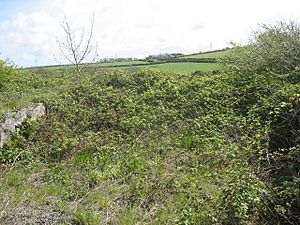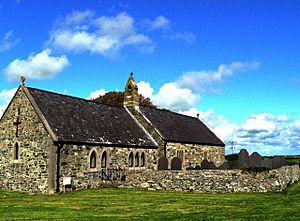St Enghenedl's Church, Llanynghenedl facts for kids
Quick facts for kids St Enghenedl's Church, Llanynghenedl |
|
|---|---|

The interior of the former church
|
|
| Lua error in Module:Location_map at line 420: attempt to index field 'wikibase' (a nil value). | |
| OS grid reference | SH316809 |
| Location | Llanynghenedl, Anglesey |
| Country | Wales, United Kingdom |
| Previous denomination | Church in Wales |
| History | |
| Status | Church |
| Founded | c.620 |
| Dedication | Enghenedl |
| Architecture | |
| Functional status | Demolished |
| Architect(s) | Henry Kennedy (1862) |
| Completed | 1862, replacing a 13th/14th-century church |
| Demolished | 1988 |
| Specifications | |
| Length | 43 ft 6 in (13.3 m) |
| Width | 15 ft 6 in (4.7 m) |
St Enghenedl's Church, Llanynghenedl, was once a local church in Anglesey, north Wales. It was named after Enghenedl, who was the son of a king from the 6th century. People believe the first church here was built around the year 620.
A new church was built in 1862. It replaced an older building that had parts from the late 1200s or early 1300s. Over time, this church was used less and less. This happened because the nearby village of Valley grew, and a new church was built there.
In 1988, St Enghenedl's Church was carefully taken apart. Its pieces were then used to make an extension for St Mihangel's Church, Llanfihangel yn Nhowyn. This allowed St Mihangel's to become the church for RAF Valley, a nearby air force base. The old churchyard of St Enghenedl's is still in its original spot. It is now being looked after.
Contents
History of St Enghenedl's Church
Where was the church located?
The place where St Enghenedl's Church used to stand is in the village of Llanynghenedl. This village is in Anglesey, north Wales. It is about 4 miles (6.4 km) east of the port town of Holyhead.
Who was Saint Enghenedl?
We do not know much about Enghenedl, the saint the church was named after. He was one of the sons of Cynan Garwyn. Cynan Garwyn was a king of a place called Powys in the late 500s. Enghenedl was also the brother of the next king, Selyf ap Cynan. This church is the only one known to be named after Enghenedl. His special day was celebrated on the Sunday before Ash Wednesday. The village of Llanynghenedl gets its name from the church. In Welsh, the word "llan" first meant "enclosure" and then came to mean "church." The "‑ynghenedl" part is a different way of saying the saint's name.
When was the church built and moved?
People say that the first church was built on this spot around the year 620. By the 1800s, this church was connected to the parish of St Machraeth's Church, Llanfachraeth.
St Enghenedl's Church was rebuilt in 1862. The architect, Henry Kennedy, designed the new building. He was the main architect for the Diocese of Bangor, which is a church area. Later, another church was built in the village of Valley. As Valley grew bigger, fewer people used St Enghenedl's. Because of this, it eventually closed.
In 1988, the church was taken apart. Its parts were then used to build an extension for St Mihangel's Church, Llanfihangel yn Nhowyn. This allowed St Mihangel's to serve the people at RAF Valley. The old west end of St Enghenedl's was joined to the west end of St Mihangel's. St Mihangel's Church was also built by Henry Kennedy in 1862. Now, the old east window of St Enghenedl's faces west, and its bell tower is in the middle of the roof. The churchyard, gravestones, and lychgate (a covered gateway to a churchyard) of St Enghenedl's are still in their original place. The churchyard is now being cared for.
What the Church Looked Like
Inside the church
In 1862, before it was rebuilt, the church was about 40 feet (12.2 meters) long and 14 feet (4.3 meters) wide inside. It had a nave (the main part of the church where people sit) and a chancel (the area near the altar). The south doorway had decorations that suggested it was from the late 1200s or early 1300s.
The church also had a font from the 1100s. A font is a basin used for baptisms. This font had a special design, similar to other fonts in Anglesey. The east window had two sections, separated by stone bars called mullions. It looked like the window of another old church, St Ylched's Church, which no longer exists.

In 1937, a survey of the rebuilt church by the Royal Commission on Ancient and Historical Monuments in Wales and Monmouthshire described it. It had a continuous nave and chancel, measuring about 43.5 feet (13.3 meters) long and 15.5 feet (4.7 meters) wide. At that time, the church was in good condition. You entered through a porch on the south side, and there was a small room called a vestry on the north side. Besides the font, the church had some memorials from the 1700s. The old font from St Enghenedl's is now in the south chapel of St Cybi's Church, Holyhead.
Church treasures
In 1906, a survey of church plate (special items used in church services) in the Bangor area found a silver chalice (a cup for wine). It was about 7.6 inches (19 cm) tall. It had a mark from Chester, showing it was made between 1724 and 1725. The chalice had the names of the vicar (Thomas Vincent) and two churchwardens (Griffith Edward and Owen Hughes), along with the year 1724. It was described as looking like an upside-down bell on a stand.
There was also a simple paten cover (a small plate for bread) that went with the chalice. It was about 3.6 inches (9 cm) across. Both the chalice and paten had the maker's mark of William Richardson. The paten also had a leopard's head mark, which meant it was checked in London.
How People Described the Church
In 1833, a writer named Angharad Llwyd said the church was "a lofty but small edifice." She also noted that several parts "display marks of very great antiquity," meaning they looked very old. Another clergyman, Harry Longueville Jones, said that its size made it "one of the least considerable" churches in Anglesey. Sir Stephen Glynne, a Welsh politician and church historian, visited the church in July 1873. He described it as a small church with "some small rude (rood)windows."

